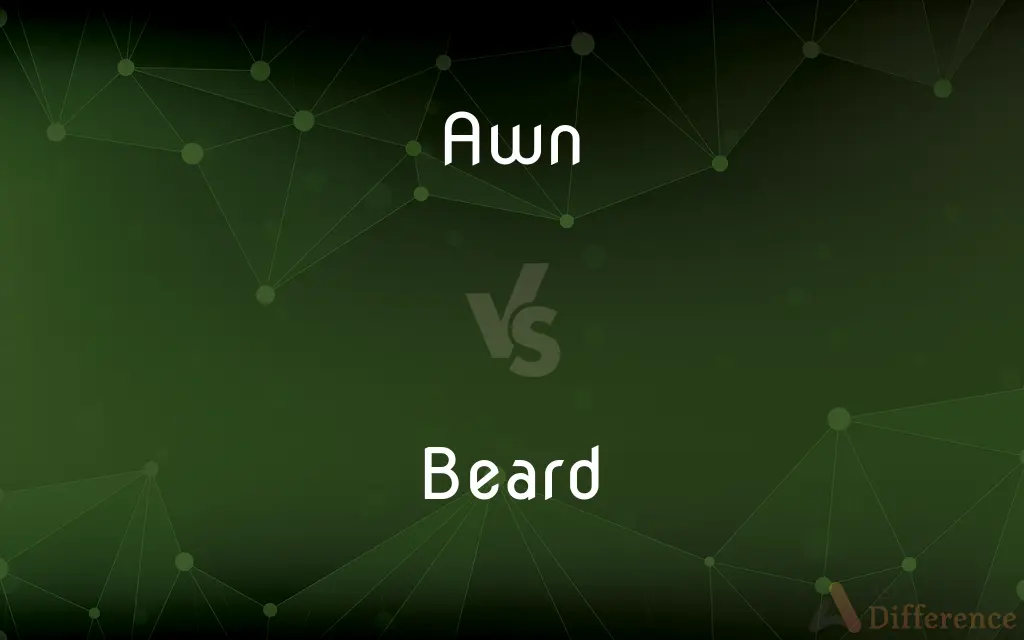Awn vs. Beard — What's the Difference?
Edited by Tayyaba Rehman — By Fiza Rafique — Updated on April 25, 2024
An awn is a bristle-like appendage on plants, aiding in seed dispersal, whereas a beard is facial hair grown on the chin and cheeks of humans, often styled for aesthetic or cultural reasons.

Difference Between Awn and Beard
Table of Contents
ADVERTISEMENT
Key Differences
An awn is typically found on the seeds of many grasses and cereals, helping to facilitate their dispersal by wind or animals. On the other hand, a beard refers to the collection of hair that grows on the chin, cheeks, and neck of humans, particularly males, and varies significantly in style and presence across different cultures and individuals.
Awns are functional parts of a plant, often stiff and pointed, which can attach to fur or fabric, thus aiding in seed dispersal. Whereas beards serve various functions ranging from physical protection to signaling maturity and enhancing the individual’s appearance according to societal norms or personal preferences.
While awns are purely natural and occur in specific plant species without human intervention, beards can be actively cultivated, trimmed, or removed, reflecting personal choice and cultural trends. This difference highlights how humans can control their appearance, in contrast to plants which rely on evolutionary traits.
Plant awns are generally uniform in appearance within species, emphasizing their role in survival rather than aesthetics. In contrast, human beards can vary greatly in terms of length, thickness, color, and style, influenced by genetic, hormonal, and cultural factors.
Comparison Chart
Definition
A bristle-like appendage found on the seeds of certain plants.
Hair that grows on the chin, cheeks, and neck of humans.
ADVERTISEMENT
Function
Aids in seed dispersal.
Can serve aesthetic, cultural, or protective purposes.
Occurrence
Naturally in many grasses and cereals.
Grows naturally but can be shaped or removed.
Variation
Uniform within species; aids survival.
Highly variable; influenced by genetics and culture.
Human Interaction
None; purely natural.
Often styled or modified.
Compare with Definitions
Awn
A slender, bristle-like fiber on plants.
The awn of the barley seed caught onto my sweater.
Beard
Hair growth on the lower face of men.
He trimmed his beard to keep it neat.
Awn
Botanical appendage aiding in reproduction.
Awns increase a plant’s chances of reproductive success.
Beard
A symbol of maturity and manhood.
His full beard was a sign of reaching adulthood.
Awn
A part of a plant involved in dispersal.
The awn helps the seed travel farther from the parent plant.
Beard
Varies culturally and individually.
In some cultures, a beard is a sign of wisdom.
Awn
A non-leaf, fibrous plant part.
Observing the awns, one can identify different grass species.
Beard
Part of facial grooming.
Regular grooming is essential for a good beard.
Awn
Specific to certain grasses.
Not all grasses have awns; their presence is species-specific.
Beard
Can be styled in various ways.
He styled his beard into a goatee.
Awn
A slender bristle, especially one at the tip of a glume or lemma in a grass spikelet.
Beard
A beard is the hair that grows on the jaw, chin, upper lip, lower lip, cheeks, and neck of humans and some non-human animals. In humans, usually pubescent or adult males are able to grow beards.
Awn
The bristle or beard of barley, oats, grasses, etc., or any similar bristlelike appendage; arista.
Beard
A growth of hair on the chin, cheeks, and throat of a person, especially a man.
Awn
The bristle or beard of barley, oats, grasses, etc., or any similar bristlelike appendage; arista.
Beard
A tuft or growth of hairs, bristles, or other hairlike threads on a plant or animal.
Awn
Slender bristlelike appendage found on the bracts of grasses
Beard
(Printing)The raised slope on a piece of type between the shoulder or counter and the face.Also called neck.
Beard
To furnish with a beard.
Beard
To confront boldly.
Beard
Facial hair on the chin, cheeks, jaw and neck.
Beard
The cluster of small feathers at the base of the beak in some birds.
Beard
The appendages to the jaw in some cetaceans, and to the mouth or jaws of some fishes.
Beard
The byssus of certain shellfish.
Beard
The gills of some bivalves, such as the oyster.
Beard
In insects, the hairs of the labial palpi of moths and butterflies.
Beard
(botany) Long or stiff hairs on a plant; the awn.
The beard of grain
Beard
A barb or sharp point of an arrow or other instrument, projecting backward to prevent the head from being easily drawn out.
Beard
The curved underside of an axehead, extending from the lower end of the cutting edge to the axehandle.
Beard
That part of the underside of a horse's lower jaw which is above the chin, and bears the curb of a bridle.
Beard
That part of a type which is between the shoulder of the shank and the face.
Beard
To grow hair on the chin and jaw.
Beard
(transitive) To boldly and bravely oppose or confront, often to the chagrin of the one being bearded.
Robin Hood is always shown as bearding the Sheriff of Nottingham.
Beard
(transitive) To take by the beard; to seize, pluck, or pull the beard of (a man), in anger or contempt.
Beard
(transitive) To deprive (an oyster or similar shellfish) of the gills.
Beard
Of bees, to accumulate together in a beard-like shape.
Beard
The hair that grows on the chin, lips, and adjacent parts of the human face, chiefly of male adults.
Beard
The long hairs about the face in animals, as in the goat.
Beard
Long or stiff hairs on a plant; the awn; as, the beard of grain.
Beard
A barb or sharp point of an arrow or other instrument, projecting backward to prevent the head from being easily drawn out.
Beard
That part of the under side of a horse's lower jaw which is above the chin, and bears the curb of a bridle.
Beard
That part of a type which is between the shoulder of the shank and the face.
Beard
An imposition; a trick.
Beard
To take by the beard; to seize, pluck, or pull the beard of (a man), in anger or contempt.
Beard
To oppose to the face; to set at defiance.
No admiral, bearded by these corrupt and dissolute minions of the palace, dared to do more than mutter something about a court martial.
Beard
To deprive of the gills; - used only of oysters and similar shellfish.
Beard
The hair growing on the lower part of a man's face
Beard
A tuft or growth of hairs or bristles on certain plants such as iris or grasses
Beard
Hairy growth on or near the face of certain mammals
Beard
Tuft of strong filaments by which e.g. a mussel makes itself fast to a fixed surface
Beard
Go along the rim, like a beard around the chin;
Houses bearded the top of the heights
Common Curiosities
Are awns found on all plants?
No, awns are specifically found on certain types of grasses and cereals, not all plants.
How do awns aid in plant reproduction?
Awns help disperse seeds away from the parent plant, increasing the likelihood of successful germination and growth.
How can beards vary between individuals?
Beards can vary based on genetics, hormonal factors, and personal grooming choices.
What cultural significances do beards have?
Beards can signify various attributes such as wisdom, authority, or virility in different cultures.
How do personal preferences influence beard styles?
Personal preferences, along with cultural trends, determine how individuals choose to style, maintain, or shave their beards.
Do all grass species have awns?
Not all grass species have awns; their presence is specific to certain species that have adapted this feature.
Is beard grooming important?
Yes, regular grooming is important for maintaining a neat, healthy beard and preventing skin issues.
What is an awn and where is it found?
An awn is a bristle-like appendage found on the seeds of certain grasses and cereals, aiding in seed dispersal.
How do hormones affect beard growth?
Hormones, particularly testosterone, play a significant role in the density, growth rate, and pattern of beard hair.
Why don’t all cereals have awns?
The presence of awns depends on the evolutionary adaptations of the plant species to their specific ecological niches.
What is the purpose of a beard?
A beard can serve various purposes such as physical protection, signaling maturity, or aesthetic enhancement.
Are awns always beneficial for plants?
Generally, awns are beneficial as they aid in seed dispersal, although in certain environments, they may not provide significant advantages.
Can awns be harmful?
Awns can be harmful if they stick to the skin or eyes of animals, including pets like dogs and cats.
Can beard style impact social perceptions?
Yes, the style and maintenance of a beard can greatly influence how an individual is perceived socially and professionally.
Can women grow beards?
Generally, women do not grow beards due to different hormonal profiles compared to men, though rare hormonal imbalances can cause beard growth in women.
Share Your Discovery

Previous Comparison
Polyester vs. Poly
Next Comparison
Overall vs. JumperAuthor Spotlight
Written by
Fiza RafiqueFiza Rafique is a skilled content writer at AskDifference.com, where she meticulously refines and enhances written pieces. Drawing from her vast editorial expertise, Fiza ensures clarity, accuracy, and precision in every article. Passionate about language, she continually seeks to elevate the quality of content for readers worldwide.
Edited by
Tayyaba RehmanTayyaba Rehman is a distinguished writer, currently serving as a primary contributor to askdifference.com. As a researcher in semantics and etymology, Tayyaba's passion for the complexity of languages and their distinctions has found a perfect home on the platform. Tayyaba delves into the intricacies of language, distinguishing between commonly confused words and phrases, thereby providing clarity for readers worldwide.
















































